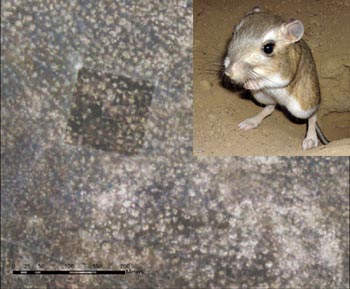Counting kangaroo rats from space
Using a borrowed spy satellite to spot this species’ distinctive burrow entrances, researchers track their numbers in hopes of protecting biodiversity on the Carrizo Plain in south-central California
| 22 October 2008
 Berkeley scientists studying the habitat needs of other small mammals in California (see related story) are monitoring the condition of the giant kangaroo rat (inset) by counting its burrows from space. Each dot in the main photo above represents a burrow on the Carrizo Plain, where the kangaroo rat is a keystone species.
Berkeley scientists studying the habitat needs of other small mammals in California (see related story) are monitoring the condition of the giant kangaroo rat (inset) by counting its burrows from space. Each dot in the main photo above represents a burrow on the Carrizo Plain, where the kangaroo rat is a keystone species.
BERKELEY — The Carrizo Plain National Monument in south-central California is the largest single native grassland remaining in the state. One of its denizens is a small creature known as the giant kangaroo rat, which has spent decades on both the federal and state endangered species lists while eking out a living on less than 2 percent of its original range. Isolated areas in Central California west of the San Joaquin Valley, like the Carrizo Plain, are all it has left.
The giant kangaroo rat is the keystone species of the Carrizo Plain, holding the ecosystem up like the center stone of an arch. If the creature’s population drops, it could mean real problems for other endangered San Joaquin Valley species, including the kit fox, blunt-nosed lizard, and antelope squirrel. The giant kangaroo rat’s burrows provide shelter for squirrels and lizards, and their chubby five-inch bodies are a favored part of the kit fox’s diet. “Without them,” says Tim Bean, a doctoral student in environmental policy and management, “the entire ecosystem would go out of whack.”
Bean and Scott Butterfield, a biologist with The Nature Conservancy, are using satellite photos to count the Carrizo Plain’s giant kangaroo rats in what amounts to the first-ever monitoring of an endangered species from outer space. To find rat burrows, they’re examining images from the same satellite Israeli defense forces use (for other purposes), in hopes of getting an accurate count of the population.
The rodents’ foraging habits make this easier than you might suspect. Some call the creatures “nature’s lawnmowers” because they clip the grasses that grow nearby, pile up the clippings in neat circles at the entrance to their burrows, then wait for the sun to cure the grass seeds, which they then store below ground. This enriches the soil, but even more happily for those charged with inventorying the critters’ numbers, the crop circles show up as distinct, countable round dots on the satellite image.
Previous population estimates came from trapping (which proved too expensive, time-consuming, and difficult to do each year across the rats’ 150,000-acre habitat) and from standard aerial surveys, which produce hand-drawn maps that vary in accuracy depending on the skill of the surveyor. Satellite sensing, by comparison, results in counts and maps that are precise, repeatable, fast, and cost-efficient.
Since the middle of the last century, farming has taken over 90 percent of the kangaroo rats’ one-time habitat. What Butterfield and Bean are doing will provide much better data to inform difficult decisions about managing the habitat that’s left. The kangaroo rats prefer a mix of short, low-to-the-ground plants. When the little clippers’ population dips, managers have to decide how else to maintain the low-profile habitat they like — for instance, by bringing in cattle to graze or doing a prescribed burn. Bean hopes to be able to predict future distribution of these endangered rodents, and to answer questions about how climate change affects them.
He’s ready for any eventuality. Under “research interests” on his Web page he says he expects that “ ‘Counting Rats From Space,’ the proposed title of my thesis, will become an international phenomenon, spawning everything from a board game to a Top 40 dance-hall burner.”

